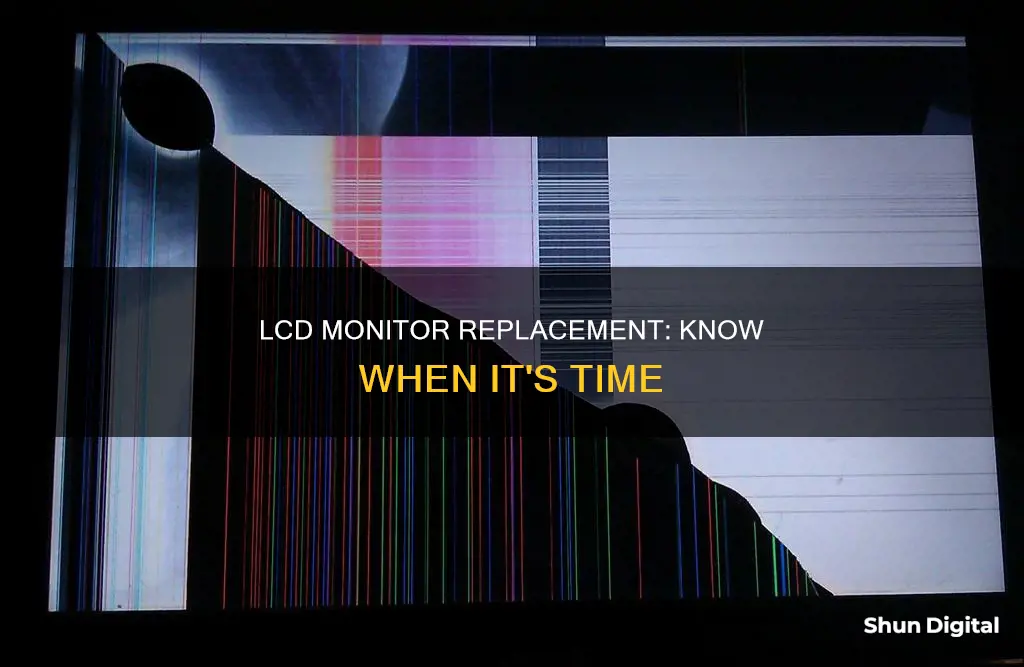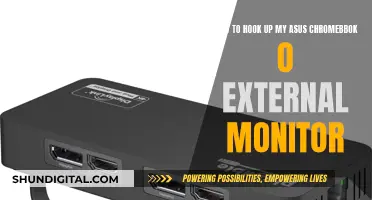
LCD monitors are vulnerable to damage from physical impacts, scratches, pressure, heat, moisture, dust, and faulty components. When deciding whether to repair or replace an LCD display, factors such as the cost and availability of parts and services, the age and condition of the device, and the difficulty and risk of the repair process should be considered. While minor issues can often be repaired at home, more severe damage, such as a cracked screen, may require a full replacement. In some cases, it may be more cost-effective to purchase a new monitor rather than repairing or replacing individual components.
What You'll Learn

When to replace the whole monitor
If your LCD monitor is damaged, you may be considering whether to repair or replace it. In some cases, it may be more cost-effective to replace the whole monitor rather than attempting to repair it. So, when should you replace the whole monitor?
Firstly, if your monitor is still under warranty, it is worth contacting the manufacturer to see if you can get it repaired for free or at a reduced price. If your monitor is no longer under warranty, the cost of repairing it may be high, especially if the damage is severe. In this case, it may be more economical to replace the monitor entirely.
Secondly, consider the availability of replacement parts. For some monitors, it can be difficult to find compatible replacement parts that match the size, resolution, connector type, and mounting method of the original display. If you can't find the right parts, replacing the whole monitor may be a more feasible option.
Thirdly, the age and condition of your monitor should be taken into account. If your monitor is getting old, a replacement may be a better option than repairing it. Additionally, if the damage to your monitor is extensive and it is in poor condition, repairing it may not be worth the time and effort.
Lastly, consider the difficulty and risk of the repair process. Some repairs can be challenging and time-consuming, especially if you don't have experience in electronics repair. If the repair is too complex or risky, it may be safer and more convenient to simply replace the monitor.
In summary, when deciding whether to replace the whole LCD monitor, consider factors such as the cost of repair, the availability of replacement parts, the age and condition of the monitor, and the difficulty and risk of the repair process. If repairing your monitor is not feasible or cost-effective, replacing it with a new one may be the best option.
Monitoring Bandwidth Usage in Linux: A Comprehensive Guide
You may want to see also

When to replace the screen
LCD monitors are fragile and can be damaged by physical impacts, scratches, pressure, heat, moisture, dust, or faulty components. If your LCD screen is cracked, broken, or malfunctioning, you may be able to repair it yourself, but in some cases, it may be more cost-effective to replace the entire screen. Here are some factors to consider when deciding whether to repair or replace your LCD screen:
Severity of Damage
If the damage is limited to a few stuck or dead pixels, you can try repairing them by gently rubbing the affected area with a damp, non-abrasive cloth or using specialised software or hardware. If the issue is minor and doesn't affect the overall functionality of the screen, you may choose to leave it as it is.
However, if the screen has spiderweb cracks, black splotches, or other signs of physical damage, it is often beyond repair. While you can attempt a repair, there is a risk of causing further harm. In such cases, it is usually more advisable to replace the screen entirely.
Cost and Difficulty of Repair
If the damage is minor and affordable to fix, and the screen is still under warranty or insurance coverage, repairing it may be a more cost-effective option. However, if the damage is extensive and the repair is expensive and complex, it may be more feasible to replace the screen, especially if the warranty period has expired.
Availability of Replacement Parts
Before attempting a repair, consider the availability of replacement parts. For LCD screens, you need to find an exact match in terms of size, resolution, connector type, and mounting method. It can be challenging to source the right parts without the right connections or an identical monitor to salvage from.
Age and Condition of the Screen
Consider the age and overall condition of your LCD screen. If it is an older model or has other issues beyond the current problem, investing in a new screen may be a better long-term decision. On the other hand, if the screen is relatively new and in good condition aside from the current issue, repairing it may be a more economical choice.
Risk of Repair
Some LCD screen repairs can expose you to dangerous high voltages. Unless you have experience in electronics repair and are confident in your abilities, it is recommended to seek the help of a professional repair service to avoid the risk of electric shock or further damage to the screen.
In summary, when deciding whether to repair or replace your LCD screen, consider the severity of the damage, the cost and difficulty of the repair, the availability of replacement parts, the age and condition of the screen, and the potential risks involved in the repair process. If the damage is extensive, repairing may be costly and challenging, and replacing the screen may be a more viable option.
Choosing the Right Studio Monitor Size for Your Setup
You may want to see also

When to repair the screen
If your LCD monitor is damaged, there are several options for repair depending on the type and extent of the damage. Here are some scenarios and suggestions on when to repair the screen:
Stuck or Dead Pixels
If you have stuck or dead pixels on your LCD screen, displaying a single colour, there are a few things you can try. You can try gently rubbing the affected pixels with a damp, non-abrasive cloth wrapped around a pencil tip or similar object. There is also specialised stuck pixel repair software available online, which works by conducting rapid colour changes to jolt the pixel back to life. Alternatively, you can purchase hardware designed to plug into your monitor to repair dead pixels. If none of these methods work, you may need to consider replacing your screen.
Minor Cracks or Scratches
If your LCD screen has minor physical damage, such as small cracks or scratches, there are repair options available. You can try gently rubbing a clean eraser over the scratch to reduce its visibility. There are also LCD scratch repair kits available for purchase. However, if the screen has major cracks or extensive physical damage, it is likely beyond repair and will need to be replaced.
Backlight Issues
If your LCD monitor is displaying a black screen but the power indicator light is on, it could be an issue with the backlight. You can try shining a flashlight onto the screen to check if an image is visible. If you can see the image, the backlight is at fault and will need to be replaced.
Power Supply Problems
If your monitor won't display an image and the power indicator lights are not turning on, it could be an issue with the power supply. This is often caused by a blown capacitor. Unless you have experience in electronics repair, it is recommended to seek the help of a professional service for this type of repair, as power supplies include dangerous high-voltage components.
Warranty Considerations
Before attempting any repairs, it is important to check if your LCD monitor is still under warranty. Most new computers come with at least a year of warranty. If your warranty is active, you can contact the manufacturer to have the issue repaired or replaced, often at a reduced cost.
Cost and Difficulty of Repairs
When deciding whether to repair or replace your LCD screen, consider the cost and difficulty of the repairs. If the damage is minor, affordable, and easy to fix, it is generally recommended to repair the screen. However, if the damage is extensive and the repairs are expensive and complex, it may be more cost-effective to replace the entire monitor, especially if the screen is no longer under warranty.
In summary, there are several scenarios where repairing your LCD screen is a viable option. However, for more severe issues, it is often more practical to replace the screen or the entire monitor.
Monitoring ACE Inhibitor Usage: Strategies for Safe Prescribing
You may want to see also

When to prevent damage
To prevent damage to your LCD display, it is important to follow some best practices for maintenance and cleaning. This includes avoiding physical impacts, scratches, pressure, heat, moisture, dust, or faulty components. Here are some specific ways to do this:
- Avoid dropping, hitting, or bending your device or display.
- Protect your device with a case, cover, or screen protector.
- Avoid exposing your device or display to extreme temperatures, humidity, or direct sunlight.
- Keep your device or display away from magnets, liquids, or corrosive substances.
- For regular cleaning, use a soft, dry, lint-free cloth or a special screen cleaner.
- Turn off your device or display when not in use and adjust the brightness and sleep settings.
By following these tips, you can ensure that your LCD display remains in good condition for longer and reduce the likelihood of needing to repair or replace it.
Opening an Acer LCD Monitor: A Step-by-Step Guide
You may want to see also

When to decide between repairing and replacing
When deciding between repairing and replacing an LCD monitor, there are several factors to consider. These include the cost and availability of parts and services, warranty and insurance coverage, the age and condition of the device and display, the difficulty and risk of the repair or replacement process, and the expected lifespan and performance of the repaired or replaced display.
If the damage to the LCD monitor is minor, the repair is affordable and straightforward, and the display is still under warranty or insurance, it is generally recommended to repair it. On the other hand, if the damage is extensive, the repair is costly and complex, and the display is no longer covered by warranty or insurance, it may be more advisable to replace it.
For those who are comfortable with technology, DIY screen repair or replacement can be a cost-effective option, especially for physical damage like cracks or chips. This involves identifying the device's model, ordering the correct replacement screen, gathering the necessary tools, backing up data, carefully removing the damaged screen, installing the new screen, and testing it before reassembling the device. DIY repairs typically cost around $50-$100 for parts and offer the satisfaction of fixing it yourself, a quick turnaround time, and the opportunity to learn about the device's internals. However, there is a risk of further damage if the repair is done incorrectly, and DIY repairs are usually limited to simpler issues.
If the damage is more complex or you are not comfortable with DIY repairs, seeking professional help is recommended. Professional repair services typically cost between $100-$300 or more, depending on the issue. When choosing a repair service, it is essential to look for certified technicians who specialize in your device brand, read online reviews, ask for quotes and warranty information, and inquire about turnaround times and guarantees.
In some cases, especially with older devices or extensive damage, replacing the entire device might be the most practical option. This is worth considering when repair costs are close to half the price of a new device, the device is several years old and showing signs of wear, you need the improved features or performance of newer models, or the device continues to have issues even after repairs.
Choosing the Right Allen Key Size for Delta Monitor Faucet
You may want to see also
Frequently asked questions
If your LCD monitor is cracked, has black splotches, or spiderweb cracks, it is likely beyond repair and you should consider replacing it.
It is not recommended to replace the screen yourself unless you are experienced in electronics repair. You will need to replace it with the exact same type of screen, as any difference in size, technology, resolution, manufacturer, or even batch will cause issues.
Replacing the monitor is much easier. Any monitor will work with any desktop PC, as long as it has the same type of connection. Modern monitors usually use HDMI or DisplayPort connections. You should look for a monitor with the same size, resolution, and refresh rate as your old one, unless you want to upgrade.
Common signs of damage include cracks or breaks on the screen, dead or stuck pixels, lines, spots, or blobs on the screen, flickering or fading of the backlight, distorted colours or contrast, blurry or ghost images, and no image or signal.
You can replace the screen yourself, but it is a difficult process and you will need to find the exact same type of screen. Alternatively, you can send it out for replacement or buy a new laptop.







